
Social Evolution and Inclusive Fitness Theory
Princeton University Press (Verlag)
978-0-691-16156-3 (ISBN)
- Lieferbar (Termin unbekannt)
- Versandkostenfrei innerhalb Deutschlands
- Auch auf Rechnung
- Verfügbarkeit in der Filiale vor Ort prüfen
- Artikel merken
Marshall highlights the general problem of identifying the underlying causes of evolutionary change, and proposes fruitful approaches to doing so in the study of social evolution. Social Evolution and Inclusive Fitness Theory describes how inclusive fitness theory addresses both simple and complex social scenarios, the controversies surrounding the theory, and how experimental work supports the theory as the most powerful explanation for social behavior and its evolution.
James A. R. Marshall is professor of theoretical and computational biology at the University of Sheffield.
List of Figures xi List of Tables xii Preface xiii Acknowlegments xvii 1 SOCIAL BEHAVIOR AND EVOLUTIONARY THOUGHT 1 1.1 Explanations for Apparent Design 1 1.2 Natural Selection and Social Behavior 3 1.3 Arguments for Group Benefit 7 1.4 Enter Hamilton 11 1.5 Multilevel Selection Theory 13 1.6 The Generality of Inclusive Fitness Theory 14 2 MODELS OF SOCIAL BEHAVIOR 16 2.1 Introduction 16 2.2 The Donation Game 18 2.3 The Nonadditive Donation Game 22 2.4 Other Social Interactions 25 2.5 Public Goods Games 28 2.6 Threshold Public Goods Games 29 2.7 Interactions in Structured Populations 32 2.8 Summary 32 3 THE PRICE EQUATION 34 3.1 A General Description of Selection 34 3.2 Genetic Selection 36 3.3 Illustrative Applications of the Price Equation 39 3.4 Important Caveats 43 3.5 Summary 45 4 INCLUSIVE FITNESS AND HAMILTON'S RULE 46 4.1 Inclusive Fitness Extends Classical Darwinian Fitness 46 4.2 Fitness Effects as Regression on Genes 47 4.3 Deriving Hamilton's Rule in the Simplest Case 51 4.4 Perceived Limitations of Inclusive Fitness Theory 54 4.5 Summary 58 5 NONADDITIVE INTERACTIONS AND HAMILTON'S RULE 59 5.1 Replicator Dynamics for Interactions between Relatives 59 5.2 Extending Hamilton's Rule to Deal with Nonadditivity 65 5.3 The Price Equation and Levels of Causal Analysis 69 5.4 Summary 70 6 CONDITIONAL BEHAVIORS AND INCLUSIVE FITNESS 71 6.1 Implicit and Explicit Conditionality 71 6.2 Modeling Conditional Behavior 73 6.3 Claims That Assortment Is More Fundamental Than Relatedness 76 6.4 Summary 77 7 VARIANTS OF HAMILTON'S RULE AND EVOLUTIONARY EXPLANATIONS 78 7.1 Variants of Hamilton's Rule 78 7.2 Geometric Relatedness Underlies Phenotypic Assortment 83 7.3 Explanations for Greenbeards 86 7.4 Different Viewpoints on Conditional Traits 88 7.5 Summary 89 8 HERITABILITY, MAXIMIZATION, AND EVOLUTIONARY EXPLANATIONS 90 8.1 What Drives Social Evolution? 90 8.2 Selection and Heritability 90 8.3 Do Individuals Act to Maximize Their Inclusive Fitness? 95 8.4 Ultimate Causes and Social Evolution 97 8.5 Summary 103 9 WHAT IS FITNESS? 105 9.1 Introduction 105 9.2 Haldane's Dilemma 105 9.3 Reproductive Value and Class Structure 107 9.4 Fitness, Fecundity, and Payoffs 109 9.5 Summary 114 10 EVIDENCE, OTHER APPROACHES, AND FURTHER TOPICS 115 10.1 Introduction 115 10.2 Empirical Support for Inclusive Fitness Theory 115 10.3 Some Further Topics in Social Evolution Theory 127 10.4 Other Theoretical Approaches 129 10.5 Conclusion 132 Glossary 135 Notes 139 Bibliography 175 Index 187
| Zusatzinfo | 7 halftones. 23 line illus. 7 tables. |
|---|---|
| Verlagsort | New Jersey |
| Sprache | englisch |
| Maße | 152 x 235 mm |
| Gewicht | 454 g |
| Themenwelt | Naturwissenschaften ► Biologie ► Evolution |
| Sozialwissenschaften ► Soziologie ► Allgemeines / Lexika | |
| ISBN-10 | 0-691-16156-9 / 0691161569 |
| ISBN-13 | 978-0-691-16156-3 / 9780691161563 |
| Zustand | Neuware |
| Haben Sie eine Frage zum Produkt? |
aus dem Bereich


